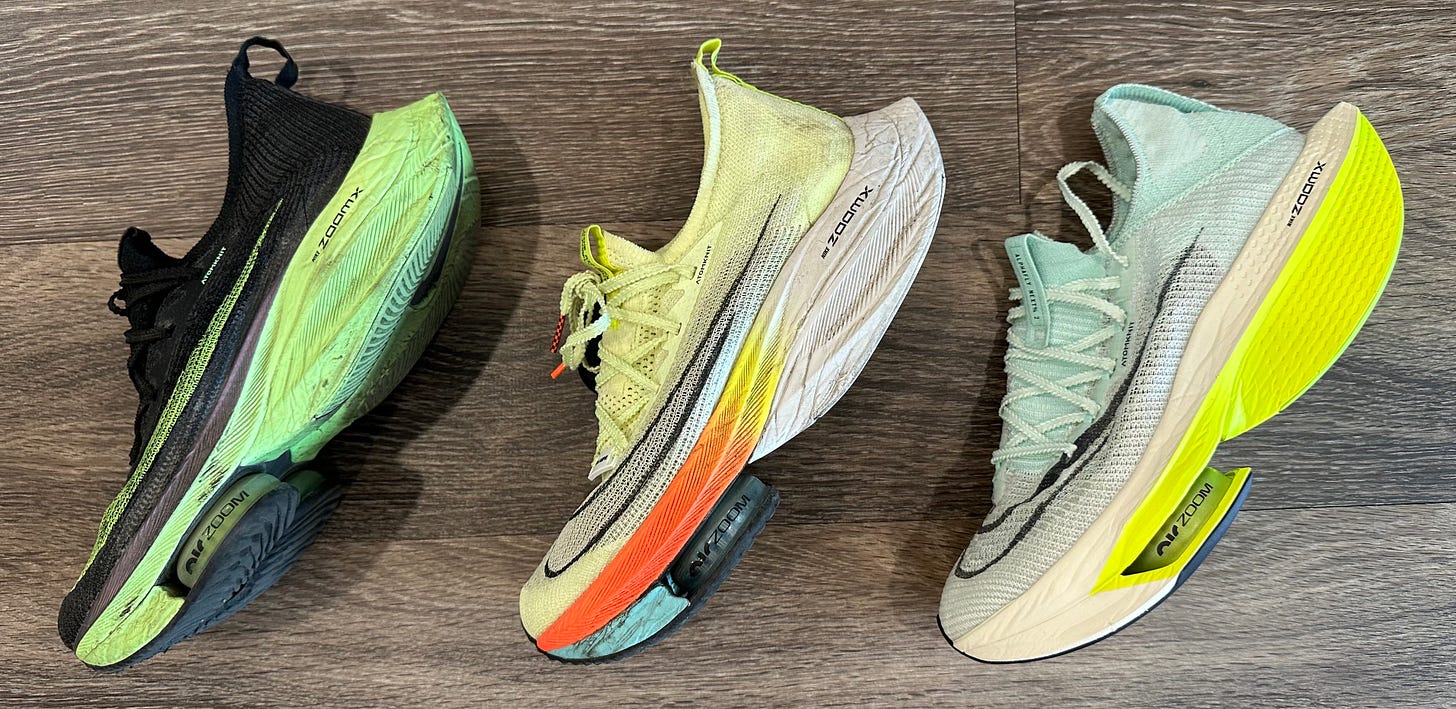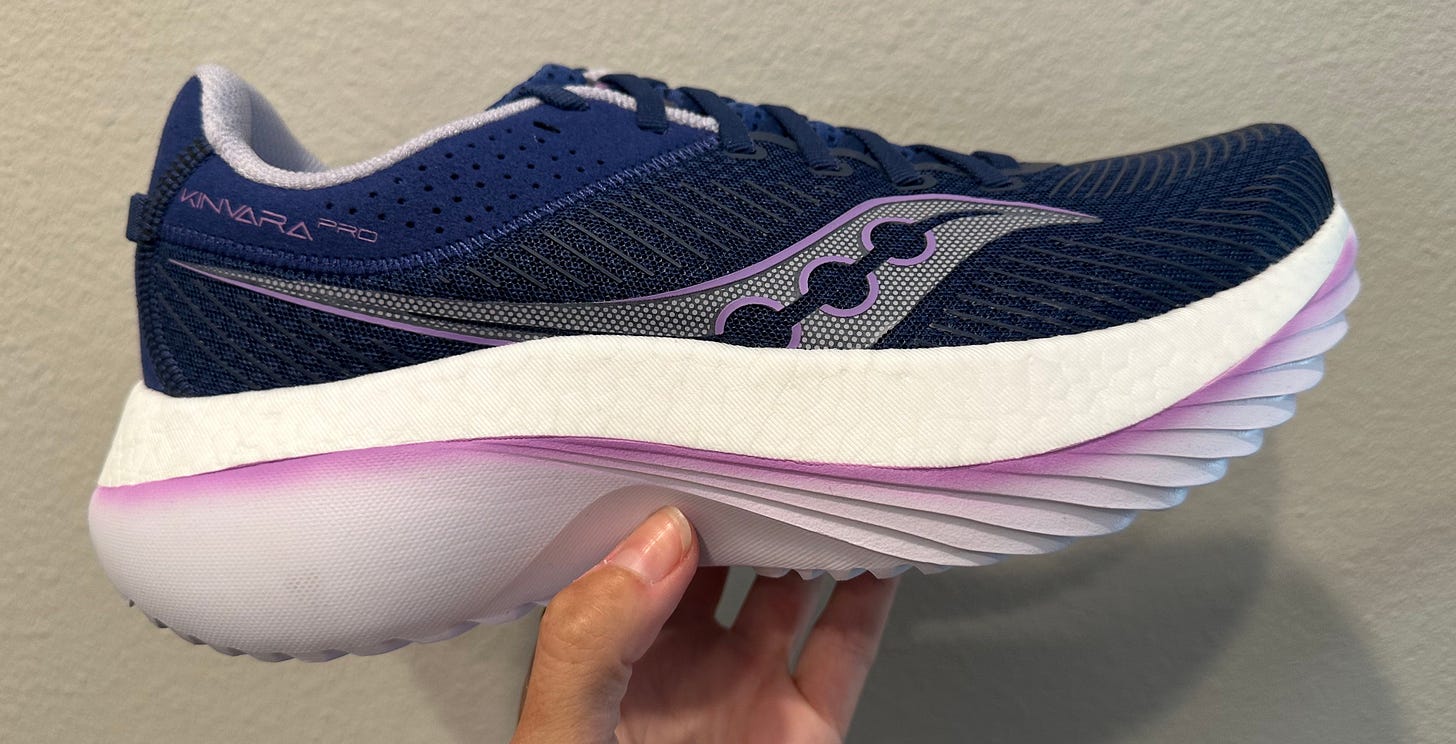Is It Time to Replace Your Running Shoes?
There's no expected lifespan for a shoe—here's how to figure out if you've killed a pair.
Recently, someone asked me what the “estimated lifetime mileage” of a super shoe was. Unfortunately, there isn’t really a ballpark lifespan for a shoe—most experts will say running shoes last 300 to 500 miles (which, by the way, is a huge range, and not at all backed by any studies), but you might get more or less out of your shoes, depending on how they’re built and how you use them.
There’s also this perception that super shoes have a sort of one-and-done magic, meaning you won’t get the same performance out of them after your first race in them. Take the Nike Air Zoom Alphafly NEXT%, for example. That shoe is designed to be so light and so fast, many marathoners have told me they feel like they’ve wrung every bit of power out of the shoe by the end of a single marathon.
Sure, you feel like it’s lost some of its pop after a big race day, but—rest assured—for that amount of money, Nike is testing it to last much longer. “They're certainly built to go longer than that,” Elliott Heath of the Nike Running Product Team told me for a story on super shoes in Runner’s World. “We have testers go many hundreds of miles, like 500, in a pair of Alphaflys. And they continue to perform.” (Personally, I ran two back-to-back marathons in a pair of the Alphaflys in 2021, and PRed in both races. And then a friend borrowed that pair and PRed in her race.)
How quickly you wear down a pair of shoes—whether it’s a super shoe or daily trainer—depends on your size, your unique biomechanics, the surface you run on, the conditions you run in, and many other factors. For example, someone running a 10-minute mile takes approximately 1,700 steps per mile, while someone running an 8-minute mile takes around 1,400 steps per mile. Runners (and the type of beating they put on their shoes) differ so much, it’s basically impossible for a brand to put an expected lifetime mileage on a specific shoe.
(One exception: On Running’s Cyclon shoe is available only via subscription; instead of a one-time cost, buyers pay $30 a month and can exchange their sneakers twice a year. On says they last up to 600 kilometers, or six to nine months—which is still a huge range, and twice a year may not be enough for some runners.)
While you can track how many miles you log in a certain shoe on Strava, in Training Peaks, or in your running watch’s partner app, when a shoe nears the end of its life, it’s less about a specific number of miles logged and more about how that shoe looks and feels. “A shoe is kind of like a muscle,” Ian Klein, an exercise physiologist specializing in cross-training and injury prevention at Ohio University, told me when I was reporting on a story for Nike. “When a muscle gets fatigued, it loses its function. So when a shoe gets fatigued or worn out, it loses its structural integrity and can no longer perform its function.”
The biggest indicator is the sole: You will literally see the signs of wear as the miles rack up, and, chances are, some sections will show more wear than others, or you’ll notice differences between the left and right shoes. Once a shoe’s sole starts to break down, it will change the way the shoe was designed to move—and you might start modifying your gait to compensate for this, which can increase your risk for injuries.
In today’s maximalist shoe era, another dead giveaway can be a shoe’s lack of bounce. A shoe’s cushioning is designed to help you spring forward (to varying degrees) and absorb impact. But with the repetitive impact of running—and the compression that causes within the shoe—you will eventually lose some of that pop, meaning it will feel like you have to work harder when you’re running. You can often see this, too; a shoe’s midsole may appear wrinkled or compressed when it’s lost some of its responsiveness. When a shoe’s ability to properly absorb shock erodes, it can also increase your risk of injury.
Finally, it’s inevitable that a shoe will lose some of its structure as you wear it out. This can be especially apparent around the heel, but also throughout the upper (especially if the fabric is tearing or stretching anywhere). If you start noticing you’re getting blisters in a tried-and-true pair of shoes, that could be a sign it’s time to upgrade. When the support and cushioning of a shoe degrades, your foot moves around more within that shoe and rubs against the fabric.
There’s no magic expiration date for a specific pair of shoes. Tracking your own mileage in whichever pairs you’re wearing can help you figure out your trends. You may be able to get 400 miles in one pair, and only 200 in another pair.
I say “pairs” because it is recommended that runners train in more than one pair of shoes. Not only will that extend a shoe’s lifespan (obviously), but runners who alternate two different pairs of running shoes have a 39 percent lower risk of running injury than those who almost always ran in the same shoes, according to a study in the Scandinavian Journal of Medicine & Science in Sports. And, whatever you do, don’t throw your running shoes in the wash! Heat, moisture, and the tumbling motion of washing machines can damage the foam and internal structures of a shoe. Instead, try these cleaning tips.
the rundown
Saucony Kinvara Pro
Saucony’s Kinvara Pro was one of the shoes I was most excited about at TRE last year; it looked like a dupe for the New Balance SuperComp Trainer I loved so much. I finally got a chance to test it out, and it feels similar, too. It’s super chunky, with a 42-millimeter stack height comprised of three layers of foam; in between is a three-quarter-length carbon plate that, combined with the shoe’s upturned toe, helps roll you efficiently through your stride. It felt a little firm to me right out of the box, but over the course of my first run in the shoe, the foam got squishier and felt more comfortable. I feel like this could be a do-it-all shoe that works as well on easy runs as it could in a marathon, at a more affordable price than the brand’s race-day options.
Tim Tollefson on the Rich Roll Podcast
The more I learn about underfueling, the more prevalent it seems in the running world. This podcast with ultrarunner Tim Tollefson was a tough listen—he’s so open about his experience with body dysmorphia and disordered eating. I thought Tollefson’s breakdown of eating disorders versus disordered eating was extremely interesting, and how the medical industry doesn’t support those who don’t fit an extremely narrow clinical definition (like, ahem, performance athletes who are extremely underfueled but still manage endurance feats). I also appreciated how Rich called out social media, and how so much fitness and diet content is shrouded in language around optimization and performance, but behind that, for a lot of people, it’s about body image and insecurity and shame and guilt. I think it’s a conversation that anyone who struggles with any mental health issues can benefit from; as Tollefson said, “you feel seen or heard when someone else talks.”
Advanced Footwear Technology Significantly Improves Female Distance Running Performance
This sort of feels obvious, based on the number of records that have been falling lately, but I love scientific backup! When researchers—in a study published in 2023 in Footwear Science—analyzed race data from the top 20 female athletes worldwide between 1990 and 2020, they found that, with advanced footwear technology (think: carbon plates, proprietary foams), marathon, half marathon, and 10K times improved by 1.7 percent, 1.72 percent, and 1.75 percent, respectively. They called it a “small but meaningful performance-enhancing effect.” This study was only done on elites, though; remember that every runner is different and not everyone responds to this kind of tech!
Thousands of Runners Disqualified from Mexico City Marathon
This story made the rounds on social media last week, and I’m still blown away by the sheer number of people who cheated (here’s the New York Times report). I’ll never understand people who cheat in endurance races—what do you gain by using public transportation, other vehicles, or a bike to compete in the race distance? This race does have a large prize purse (550,000 pesos, or more than $31,000), but we’re talking about normal people, not pros, cheating. And this isn’t the first time this has happened: In 2018, 3,090 runners were disqualified, and in 2017, 5,806 people were disqualified. If you don’t want to run 26.2 miles, maybe just…don’t sign up for a marathon? Because you’re going to get found out.





Reading about the Mexico City stuff on Reddit several people from there said they always do series of medals that spell out a word (gotta run 4-6 years to get them all). People want the medal from each year to complete the set but don’t want to run every year so they jump in late, take transit, cut the course, etc.
I still can’t understand the mindset but it helps explain such a massive number of cheats.